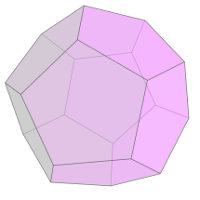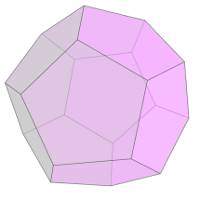By Michael Hartley
Imagine this : your friend chooses a polyhedorn (three-dimensional shape) and hides it. Then he or she counts the number of edges the shape has, and tells you just this number. Then, you tell your friend the total number of vertices, edges and faces on the whole shape!
Does that sound like a good trick? If so, let me tell you how it can be done.
First of all, you need to be sure that your friend has chosen
- A three-dimensional shape
- with only flat faces and straight edges, and
- no holes.
Second, ask your friend to count the number of edges carefully, then tell you the total. They have to count correctly!
Whatever number they tell you, double it, and add two.. The answer you get will be the total number of faces, edges and vertices on the whole shape!
Let me give an example. Suppose your friend chose a square pyramid. This shape has 5 vertices, 8 edges, and 5 faces. Your friend tells you "The number of edges is 8." If you double 8, you get 16. Add two, and you get 18. So you say, "The total number of vertices, edges and faces is 18." Sure enough, 5 vertices + 8 edges + 5 faces equals 18!
Suppose instead your friend chose a cube. The cube has 8 vertices, 12 edges, and 6 faces. Your friend tells you "The number of edges is 12." Then you work out - "double 12 is 24, plus 2 is 26." Sure enough, the total number of vertices, edges and faces on the cube is 8 + 12 + 6 = 26.
How does this puzzle work?
This puzzle works because of a famous formula, called "Euler's formula", that says that if you take the number of vertices of a three-dimensional polyhedron - with no holes, and no curved faces or edges, that is... if you take the number of vertices V, subtract the number of edges E, and add the number of faces F, you get V - E + F = 2.

A dodecahedron
Don't believe it? Try it!
- The Triangular Pyramid has V=4, E=6, F=4, and 4-6+4=2.
- The Square pyramid has V=5, E=8, F=5, and 5-8+5=2.
- A Pentagonal Pyramid has V=6, E=10, F=6 and 6-10+6=2.
- A triangular prism has V=6, E=9, F=5 and 6-9+5=2.
- A cube as V=8, E=12, F=6 and 8-12+6=2.
- A Dodecahedron (shown here) has V=20, E=30, F=12, and 20-30+12=2.
So, what's this got to do with this magic trick? Well, if the number of vertices, minus the number of edges, plus the number of faces is always 2 (that is, V-E+F=2), then the total number of vertices and faces is equal to two more than the number of edges (that is, V+F=E+2). That means that the total number of vertices, faces and egdes (V+F+E) will be twice the number of edges, plus two (E+E+2).
Let's try it on the shapes I mentioned above.
- The Triangular Pyramid has V=4, E=6, F=4. The total is 14, but 2xE+2 = 2x6+2=14.
- The Square pyramid has V=5, E=8, F=5. The total is 18, but 2xE+2 = 2x8+2=18.
- A Pentagonal Pyramid has V=6, E=10. The total is 22, but 2xE+2 = 2x10+2=22.
- A triangular prism has V=6, E=9, F=5. The total is 20, but 2xE+2 = 2x9+2=20.
- A cube as V=8, E=12, F=6. The total is 26, but 2xE+2 = 2x12+2=26.
- A dodecahedron has V=20, E=30, F=12. The total is 62, but 2xE+2 = 2x30+2=62.
- Maybe the shape has curved edges. The trick won't work on a cone, a cylinder or a ball.
- Maybe the shape has a hole in it. The trick won't work on a donut shape, even a donut shape with all flat faces and straight edges.
- Maybe your friend just didn't count properly!
There's also a similar trick - you can play with maps. Take any map, and count
- The number of regions (eg, states or countries). Call this F.
- The number of borders between countries or states. Call this E.
- The number of "corners" where three or more countries or states meet. Call this V.
- You don't have any holes in your map (eg, make sure lakes and oceans get counted either as regions, or as boundaries of some sort)
- No country completely encloses another (eg, this trick won't work with a map of Africa - do you know why?)
- It's possible to trace along the borders from any point on any border to any other.
- No country has a border with itself.
